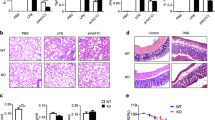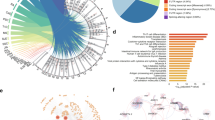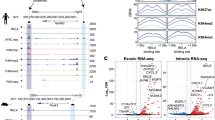Abstract
Inflammation is characterized by a biphasic cycle consisting initially of a proinflammatory phase that is subsequently resolved by anti-inflammatory processes. Interleukin-1β (IL-1β) is a master regulator of proinflammation and is encoded within the same topologically associating domain (TAD) as IL-37, which is an anti-inflammatory cytokine that opposes the function of IL-1β. Within this TAD, we identified a long noncoding RNA called AMANZI, which negatively regulates IL-1β expression and trained immunity through the induction of IL37 transcription. We found that the activation of IL37 occurs through the formation of a dynamic long-range chromatin contact that leads to the temporal delay of anti-inflammatory responses. The common variant rs16944 present in AMANZI augments this regulatory circuit, predisposing individuals to enhanced proinflammation or immunosuppression. Our work illuminates a chromatin-mediated biphasic circuit coordinating expression of IL-1β and IL-37, thereby regulating two functionally opposed states of inflammation from within a single TAD.
This is a preview of subscription content, access via your institution
Access options
Access Nature and 54 other Nature Portfolio journals
Get Nature+, our best-value online-access subscription
$29.99 / 30 days
cancel any time
Subscribe to this journal
Receive 12 print issues and online access
$209.00 per year
only $17.42 per issue
Buy this article
- Purchase on Springer Link
- Instant access to full article PDF
Prices may be subject to local taxes which are calculated during checkout








Similar content being viewed by others

Data availability
Code availability
No code was generated in the present study.
References
Garly, M.-L. et al. BCG scar and positive tuberculin reaction associated with reduced child mortality in West Africa. A non-specific beneficial effect of BCG? Vaccine 21, 2782–2790 (2003).
Kleinnijenhuis, J. et al. Bacille Calmette–Guerin induces NOD2-dependent nonspecific protection from reinfection via epigenetic reprogramming of monocytes. Proc. Natl Acad. Sci. USA 109, 17537–17542 (2012).
Garlanda, C., Dinarello, C. A. & Mantovani, A. The interleukin-1 family: back to the future. Immunity 39, 1003–1018 (2013).
Arts, R. J. W. et al. BCG vaccination protects against experimental viral infection in humans through the induction of cytokines associated with trained immunity. Cell Host Microbe 23, 89–100.e5 (2018).
Dinarello, C. A. A clinical perspective of IL-1β as the gatekeeper of inflammation. Eur. J. Immunol. 41, 1203–1217 (2011).
Netea, M. G. et al. A guiding map for inflammation. Nat. Immunol. 18, 826–831 (2017).
The 1000 Genomes Project Consortium. A global reference for human genetic variation. Nature 526, 68–74 (2015).
Wu, X. et al. Association of interleukin‐1 gene variations with moderate to severe chronic periodontitis in multiple ethnicities. J. Periodontal Res. 50, 52–61 (2015).
Huang, X.-L. et al. Association of interleukin-1 family cytokines single nucleotide polymorphisms with susceptibility to systemic sclerosis: an independent case-control study and a meta-analysis. Immunol. Res. 64, 1041–1052 (2016).
Li, D., Li, J., Wang, L. & Zhang, Q. Association between IL-1β, IL-8, and IL-10 polymorphisms and risk of acute pancreatitis. Genet. Mol. Res. 14, 6635–6641 (2015).
Jimenez-Sousa, M. A. et al. IL-1β rs16944 polymorphism is related to septic shock and death. Eur. J. Clin. Invest. 47, 53–62 (2017).
Awomoyi, A. A. et al. Polymorphism in IL1B: IL1B-511 association with tuberculosis and decreased lipopolysaccharide-induced IL-1beta in IFN-gamma primed ex-vivo whole blood assay. J. Endotoxin Res. 11, 281–286 (2005).
Fan, J. et al. Variations in IL-1R1 gene influence risk for hepatitis B virus infection of children in a Han Chinese population. Int. J. Infect. Dis. 55, 45–50 (2017).
Wojtowicz, A. et al. IL1B and DEFB1 polymorphisms increase susceptibility to invasive mold infection after solid-organ transplantation. J. Infect. Dis. 211, 1646–1657 (2015).
Nold, M. F. et al. IL-37 is a fundamental inhibitor of innate immunity. Nat. Immunol. 11, 1014–1022 (2010).
Li, S. et al. Extracellular forms of IL-37 inhibit innate inflammation in vitro and in vivo but require the IL-1 family decoy receptor IL-1R8. Proc. Natl Acad. Sci. USA 112, 2497–2502 (2015).
Li, S. et al. Role for nuclear interleukin-37 in the suppression of innate immunity. Proc. Natl Acad. Sci. USA 116, 4456–4461 (2019).
Cavalli, G. et al. The anti-inflammatory cytokine interleukin-37 is an inhibitor of trained immunity. Cell Rep. 35, 108955 (2021).
Xu, W.-D., Zhao, Y. & Liu, Y. Insights into IL-37, the role in autoimmune diseases. Autoimmun. Rev. 14, 1170–1175 (2015).
Offenbacher, S. et al. GWAS for Interleukin-1β levels in gingival crevicular fluid identifies IL37 variants in periodontal inflammation. Nat. Commun. 9, 3686 (2018).
Dixon, J. R. et al. Topological domains in mammalian genomes identified by analysis of chromatin interactions. Nature 485, 376–380 (2012).
Li, G. et al. Extensive promoter-centered chromatin interactions provide a topological basis for transcription regulation. Cell 148, 84–98 (2012).
Rocha, P. P., Raviram, R., Bonneau, R. & Skok, J. A. Breaking TADs: insights into hierarchical genome organization. Epigenomics 7, 523–526 (2015).
Fanucchi, S., Shibayama, Y., Burd, S., Weinberg, M. S. & Mhlanga, M. M. Chromosomal contact permits transcription between coregulated genes. Cell 155, 606–620 (2013).
Fanucchi, S. et al. Immune genes are primed for robust transcription by proximal long noncoding RNAs located in nuclear compartments. Nat. Genet. 51, 138–150 (2019).
Kung, J. T., Colognori, D. & Lee, J. T. Long noncoding RNAs: past, present, and future. Genetics 193, 651–669 (2013).
van Solingen, C. et al. Long noncoding RNA CHROMR regulates antiviral immunity in humans. Proc. Natl Acad. Sci. USA 119, e2210321119 (2022).
Wang, K. C. et al. A long noncoding RNA maintains active chromatin to coordinate homeotic gene expression. Nature 472, 120–124 (2011).
Lai, F. et al. Activating RNAs associate with mediator to enhance chromatin architecture and transcription. Nature 494, 497–501 (2013).
Ostuni, R. et al. Latent enhancers activated by stimulation in differentiated cells. Cell 152, 157–171 (2013).
Andersson, R. et al. An atlas of active enhancers across human cell types and tissues. Nature 507, 455–461 (2014).
Shibayama, Y., Fanucchi, S. & Mhlanga, M. M. in Enhancer RNAs (ed. Ørom, U. A.) 19–32 (Springer, 2017).
Kaufmann, E. et al. BCG educates hematopoietic stem cells to generate protective innate immunity against tuberculosis. Cell 172, 176–190.e19 (2018).
Mitroulis, I. et al. Modulation of myelopoiesis progenitors is an integral component of trained immunity. Cell 172, 147–161.e12 (2018).
Moorlag, S.J.C.F.M., Roring, R. J., Joosten, L. A. B. & Netea, M. G. The role of the interleukin-1 family in trained immunity. Immunol. Rev. 281, 28–39 (2018).
Li, Y. et al. Inter-individual variability and genetic influences on cytokine responses to bacteria and fungi. Nat. Med. 22, 952–960 (2016).
Novakovic, B. et al. β-Glucan reverses the epigenetic state of LPS-induced immunological tolerance. Cell 167, 1354–1368.e14 (2016).
Dos Santos, J. C. et al. β-Glucan-induced trained immunity protects against Leishmania braziliensis infection: a crucial role for IL-32. Cell Rep. 28, 2659–2672.e6 (2019).
Heintzman, N. D. et al. Distinct and predictive chromatin signatures of transcriptional promoters and enhancers in the human genome. Nat. Genet. 39, 311–318 (2007).
Buecker, C. & Wysocka, J. Enhancers as information integration hubs in development: lessons from genomics. Trends Genet. 28, 276–284 (2012).
Calo, E. & Wysocka, J. Modification of enhancer chromatin: what, how, and why? Mol. Cell 49, 825–837 (2013).
Lupianez, D. G., Spielmann, M. & Mundlos, S. Breaking TADs: how alterations of chromatin domains result in disease. Trends Genet. 32, 225–237 (2016).
Dekker, J. & Mirny, L. The 3D genome as moderator of chromosomal communication. Cell 164, 1110–1121 (2016).
Loda, A., Collombet, S. & Heard, E. Gene regulation in time and space during X-chromosome inactivation. Nat. Rev. Mol. Cell Biol. 23, 231–249 (2022).
Rao, S. S. P. et al. A 3D map of the human genome at kilobase resolution reveals principles of chromatin looping. Cell 159, 1665–1680 (2014).
Javierre, B. M. et al. Lineage-specific genome architecture links enhancers and non-coding disease variants to target gene promoters. Cell 167, 1369–1384.e19 (2016).
Ilott, N. E. et al. Long non-coding RNAs and enhancer RNAs regulate the lipopolysaccharide-induced inflammatory response in human monocytes. Nat. Commun. 5, 3979 (2014).
Saldaña-Meyer, R. et al. RNA interactions are essential for CTCF-mediated genome organization. Mol. Cell. 76, 412–422.e5 (2019).
Li, W. et al. Functional roles of enhancer RNAs for oestrogen-dependent transcriptional activation. Nature 498, 516–520 (2013).
Shibayama, Y., Fanucchi, S., Magagula, L. & Mhlanga, M. M. lncRNA and gene looping: what’s the connection? Transcription 5, e28658 (2014).
Grimsby, S. et al. Proteomics-based identification of proteins interacting with Smad3: SREBP-2 forms a complex with Smad3 and inhibits its transcriptional activity. FEBS Lett. 577, 93–100 (2004).
Dinarello, C. A. et al. Suppression of innate inflammation and immunity by interleukin-37. Eur. J. Immunol. 46, 1067–1081 (2016).
Wang, X. et al. N6-Methyladenosine modulates messenger RNA translation efficiency. Cell 161, 1388–1399 (2015).
Macveigh-Fierro, D., Cicerchia, A., Cadorette, A., Sharma, V. & Muller, M. The m6A reader YTHDC2 is essential for escape from KSHV SOX-induced RNA decay. Proc. Natl Acad. Sci. USA 119, e2116662119 (2022).
Moretto, F., Wood, N. E., Kelly, G., Doncic, A. & van Werven, F. J. A regulatory circuit of two lncRNAs and a master regulator directs cell fate in yeast. Nat. Commun. 9, 780 (2018).
Fanucchi, S., Dominguez-Andres, J., Joosten, L. A. B., Netea, M. G. & Mhlanga, M. M. The intersection of epigenetics and metabolism in trained immunity. Immunity 54, 32–43 (2021).
Xie, S.-J. et al. Characterization of long non-coding RNAs modified by m6A RNA methylation in skeletal myogenesis. Front. Cell Dev. Biol. 9, 762669 (2021).
Hotchkiss, R. S., Coopersmith, C. M., McDunn, J. E. & Ferguson, T. A. The sepsis seesaw: tilting toward immunosuppression. Nat. Med. 15, 496–497 (2009).
Shalova, I. N. et al. Human monocytes undergo functional re-programming during sepsis mediated by hypoxia-inducible factor-1α. Immunity 42, 484–498 (2015).
Cheng, S.-C. et al. Broad defects in the energy metabolism of leukocytes underlie immunoparalysis in sepsis. Nat. Immunol. 17, 406–413 (2016).
Wang, Y.-C., Weng, G.-P., Liu, J.-P., Li, L. & Cheng, Q.-H. Elevated serum IL-37 concentrations in patients with sepsis. Medicine 98, e14756 (2019).
Singer, M. et al. The Third International Consensus definitions for sepsis and septic shock (sepsis-3). JAMA 315, 801–810 (2016).
Hirschfeld, M., Ma, Y., Weis, J. H., Vogel, S. N. & Weis, J. J. Cutting edge: repurification of lipopolysaccharide eliminates signaling through both human and murine toll-like receptor 2. J. Immunol. 165, 618–622 (2000).
van der Sande, M. et al. seq2science (v1.1.0). Zenodo https://doi.org/10.5281/zenodo.8343776 (2023).
Hagege, H. et al. Quantitative analysis of chromosome conformation capture assays (3C-qPCR). Nat. Protoc. 2, 1722–1733 (2007).
Gräwe, C., Hernandez-Quiles, M., Jansen, P. W. T. C., Brimmers, A. & Vermeulen, M. Determining DNA–protein binding affinities and specificities from crude lysates using a combined SILAC/TMT labeling strategy. J. Proteome Res. 22, 2683–2693 (2023).
Dominissini, D., Moshitch-Moshkovitz, S., Salmon-Divon, M., Amariglio, N. & Rechavi, G. Transcriptome-wide mapping of N6-methyladenosine by m6A-seq based on immunocapturing and massively parallel sequencing. Nat. Protoc. 8, 176–189 (2013).
Acknowledgements
We thank all members of the Epigenomics & Single Cell Biophysics Group (Mhlanga laboratory) and all members of the laboratories of M.G.N., L.A.B.J. and P.S. We thank INTRIM consortium members for comments on the paper. We thank R. Weinlich for contributing reagents and participants to the present study and G. B. Olivato and F. B. Hohmann for ICU patients’ data collection. We thank all volunteers in the 200FG cohort. The Vermeulen laboratory is part of the Oncode Institute, which is partly funded by the Dutch Cancer Society.
Author information
Authors and Affiliations
Contributions
E.T.F., S.F., M.G.N. and M.M.M. designed the study. E.T.F. and S.J.C.F.M.M. performed most experiments and collected and analyzed data. S.J.C.F.M.M., L.A.G. and J.C.d.S. performed the experiments on healthy human-derived monocytes. D.P.d.C.J., L.B.M., A.S.N. and P.S. performed the experiments on whole blood from patients with sepsis and septic shock. Y.N. carried out data analysis. V.V.M., D.D.D.C. and M.v.R. conducted experiments and analyzed data. E.T.F., S.J.C.F.M.M., S.F., L.A.B.J., P.S., M.G.N. and M.M.M. discussed and edited the paper. E.T.F., S.F. and M.M.M. co-wrote the paper. M.M.M. designed experiments, analyzed data and supervised the study.
Corresponding author
Ethics declarations
Competing interests
M.M.M. and S.F. are founders of Lemba Therapeutics. M.G.N. and L.A.B.J. are founders of TTxD. M.M.M., S.F., M.G.N. and L.A.B.J. are equity holders in Lemba Therapeutics. The other authors declare no competing interests.
Peer review
Peer review information
Nature Genetics thanks Howard Chang, Maziar Divangahi, Kathryn Moore and the other, anonymous, reviewer(s) for their contribution to the peer review of this work. Peer reviewer reports are available.
Additional information
Publisher’s note Springer Nature remains neutral with regard to jurisdictional claims in published maps and institutional affiliations.
Supplementary information
Supplementary Information
Supplementary Notes 1–8 and Figs. 1–11.
Supplementary Table 1
RNA-seq count table.
Supplementary Table 2
Proteomics table showing significant hits.
Supplementary Table 3
Reagents and materials.
Rights and permissions
Springer Nature or its licensor (e.g. a society or other partner) holds exclusive rights to this article under a publishing agreement with the author(s) or other rightsholder(s); author self-archiving of the accepted manuscript version of this article is solely governed by the terms of such publishing agreement and applicable law.
About this article
Cite this article
Fok, E.T., Moorlag, S.J.C.F.M., Negishi, Y. et al. A chromatin-regulated biphasic circuit coordinates IL-1β-mediated inflammation. Nat Genet 56, 85–99 (2024). https://doi.org/10.1038/s41588-023-01598-2
Received:
Accepted:
Published:
Issue Date:
DOI: https://doi.org/10.1038/s41588-023-01598-2


